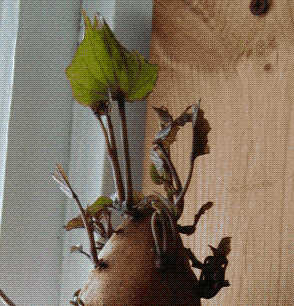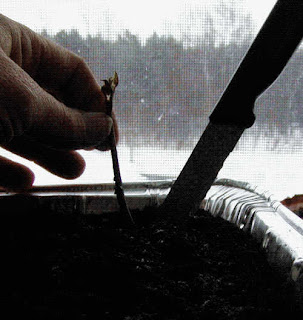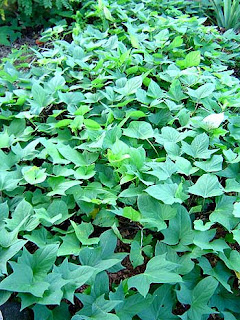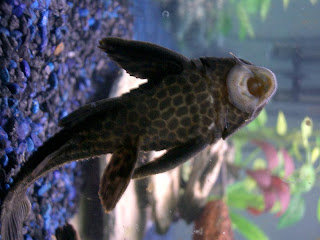I want interesting pie and wine making material. We don't eat much jam but the guys do consume an amazing amount of pie!

One thing I am growing a lot of this year are ground cherries, also called "cape gooseberries". I grew ground cherries last year and they were delicious! I am planting a lot more of them this year.
 I have planted chichiquelites, also called garden huckleberries (solanum nigrum). Mine are about an inch tall right now. I have read that they grow into very large and spreading shrubs that are covered with berries. Sounds good to me! They are said to taste like small, very tart blueberries needing a lot of sugar. I can add more sugar for pies and I think that sounds like a good description of something that will make a tasty wine!
I have planted chichiquelites, also called garden huckleberries (solanum nigrum). Mine are about an inch tall right now. I have read that they grow into very large and spreading shrubs that are covered with berries. Sounds good to me! They are said to taste like small, very tart blueberries needing a lot of sugar. I can add more sugar for pies and I think that sounds like a good description of something that will make a tasty wine!A new and interesting berry is the blue honeysuckle berry, or perhaps this is a very old berry that is making a comeback. One variety of this is called a "Haskap" and grow mainly in the western provinces. It looks like a large oval blueberry and it taste similar to a blueberry, although perhaps not as sweet, or so I have read.
 In addition to the ones above, I have also collected seed for:
In addition to the ones above, I have also collected seed for:Red Elderberries
Choke Cherries
High Bush Cranberries (viburnam)
Mulberries
Sweet Low Blueberries
Red and Black currents
 I have red raspberries and a large patch of wild black raspberries. I am looking for green gooseberries to add, as well.
I have red raspberries and a large patch of wild black raspberries. I am looking for green gooseberries to add, as well.Another good berry for winemaking is the goji berry. I planted goji berries last spring and grew my own plants. They are overwintering outside under the snow and are said to be very hardy. We will see when spring comes.
 I know growing these things from seed will take a few years. I will also actively search out cuttings to root and, perhaps, actually purchase plants from a nursery if they are available.
I know growing these things from seed will take a few years. I will also actively search out cuttings to root and, perhaps, actually purchase plants from a nursery if they are available. I will be purchasing strawberries this spring but not everbearing. We grew everbearing strawberries for the past couple of years. While they reproduced at an amazing rate, they did not grow a noticeable crop of large berries at any one time. It could have been the cold wet summer, but I have read that the everbearing type produce smaller berries and not all at once. I want enough large strawberries to make a 23 litre batch of wine, so I am planting regular ones this year, and lots of them. I will probably pick them elsewhere this year, giving our new plants the summer to establish themselves.
I will be purchasing strawberries this spring but not everbearing. We grew everbearing strawberries for the past couple of years. While they reproduced at an amazing rate, they did not grow a noticeable crop of large berries at any one time. It could have been the cold wet summer, but I have read that the everbearing type produce smaller berries and not all at once. I want enough large strawberries to make a 23 litre batch of wine, so I am planting regular ones this year, and lots of them. I will probably pick them elsewhere this year, giving our new plants the summer to establish themselves. I have planted most of these berry and shrub seeds that I have collected. I planted all of the different types in small trays, covered with plastic. Some I put upstairs in the very warm growing room. Those that I know require winter stratification were planted in trays, covered and put outside on the front porch under the potting bench. Some extra seeds was put into the freezer for storage.
I have planted most of these berry and shrub seeds that I have collected. I planted all of the different types in small trays, covered with plastic. Some I put upstairs in the very warm growing room. Those that I know require winter stratification were planted in trays, covered and put outside on the front porch under the potting bench. Some extra seeds was put into the freezer for storage.I am still researching hardy berries for wine and pies. I am certain there are more of them out there. Many of these are old heirlooms not grown anymore. We are responsible for the seed we have lost. I want to keep a repository for all the old varieties.











































